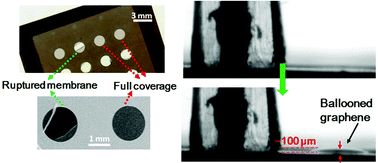Ultra-large suspended graphene as a highly elastic membrane for capacitive pressure sensors†
Abstract
In this work, we fabricate ultra-large suspended graphene membranes, where stacks of a few layers of graphene could be suspended over a circular hole with a diameter of up to 1.5 mm, with a diameter to thickness aspect ratio of 3 × 105, which is the record for free-standing graphene membranes. The process is based on large crystalline graphene (∼55 μm) obtained using a chemical vapor deposition (CVD) method, followed by a gradual solvent replacement technique. Combining a hydrogen bubbling transfer approach with thermal annealing to reduce polymer residue results in an extremely clean surface, where the ultra-large suspended graphene retains the intrinsic features of graphene, including phonon response and an enhanced carrier mobility (200% higher than that of graphene on a substrate). The highly elastic mechanical properties of the graphene membrane are demonstrated, and the Q-factor under 2 MHz stimulation is measured to be 200–300. A graphene-based capacitive pressure sensor is fabricated, where it shows a linear response and a high sensitivity of 15.15 aF Pa−1, which is 770% higher than that of frequently used silicon-based membranes. The reported approach is universal, which could be employed to fabricate other suspended 2D materials with macro-scale sizes on versatile support substrates, such as arrays of Si nano-pillars and deep trenches.


 Please wait while we load your content...
Please wait while we load your content...